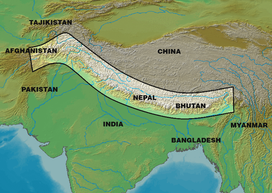Himalayan range
| Himalayas | |
|---|---|

The north face of Mount Everest seen from the path to the base camp in Tibet Autonomous Region, China
|
|
| Highest point | |
| Peak | Mount Everest (Nepal and China) |
| Elevation | 8,848 m (29,029 ft) |
| Coordinates | 27°59′17″N 86°55′31″E / 27.98806°N 86.92528°ECoordinates: 27°59′17″N 86°55′31″E / 27.98806°N 86.92528°E |
| Dimensions | |
| Length | 2,400 km (1,500 mi) |
| Geography | |
| Countries | |
| State/Province | Asia |
The Himalayas, or Himalaya, (/ˌhɪməˈleɪ.ə/ or /hɪˈmɑːləjə/) form a mountain range in Asia separating the plains of the Indian subcontinent from the Tibetan Plateau.
The Himalayan range has many of the Earth's highest peaks, including the highest, Mount Everest. The Himalayas include over fifty mountains exceeding 7,200 metres (23,600 ft) in elevation, including ten of the fourteen 8000m peaks. By contrast, the highest peak outside Asia – Aconcagua, in the Andes – is 6,961 metres (22,838 ft) tall.
The Himalayan range is bordered on the northwest by the Karakoram and Hindu Kush ranges, on the north by the Tibetan Plateau, and on the south by the Indo-Gangetic Plain. The Himalayas are distinct from the other great ranges of central Asia, although sometimes the term Himalaya is loosely used to include the Karakoram and some of the other ranges. The Himalayas are spread across five countries: Nepal, India, Bhutan, China and Pakistan, with the first three countries having sovereignty over most of the range. Some of the world's major rivers, the Indus, the Ganges, and the Tsangpo-Brahmaputra, rise in the Himalayas, and their combined drainage basin is home to roughly 600 million people. The Himalayas have profoundly shaped the cultures of South Asia; many Himalayan peaks are sacred in Hinduism and Buddhism.
...
Wikipedia

